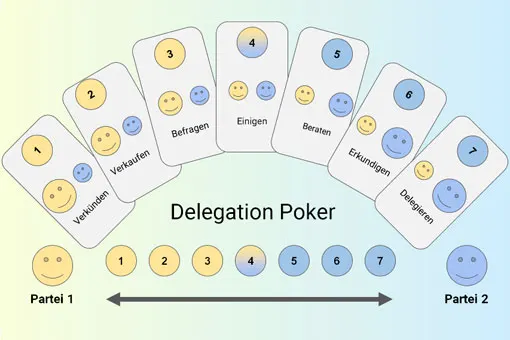Leading agilely with success – Agile Leadership
Five dimenions of "Agile Leadership"
Five theses on "Agile Leadership"
Thesis 1: Agile Leadership is the answer to a changed reality.
Thesis 2: Companies profit from confident employees who are able to assess risks and dare to do something.
The desire for something new or the preference for security: static and dynamic mindsets.
Have you checked your mindset today?
3. The task of a manager in Agile Leadership is to encourage employees to leave well-trodden paths and to think and act in an agile way.
4. A team on the way to agility learns most from its leaders.
5. Agile Leadership is characterized above all by competence in communication and the ability to create a trusting working atmosphere.
So, "agile leadership" it is?
Develop agile leadership skills with Pink University
Five dimenions of "Agile Leadership"
What can you lead in an agile way? What makes an "Agile
Leader"? Find out in our video "
Five theses on "Agile Leadership"
Thesis 1: Agile Leadership is the answer to a changed
reality.
Above all, "Agile Leadership" is necessary because
customers are more demanding than ever before. At the same time, they are less
and less willing to commit to companies and brands. Good for those who actually
put their customers center stage.
At the same time there is a lot of movement. New competitors, technologies, ideas and occasionally crises, such as Covid, enterthe scene from all sides.
This is now our present: unstable, uncertain, complex and
ambiguous. Welcome to the VUCA world. Companies must learn to quickly respond
to changes, or even better: recognize opportunities and set trends.

Traditional business structures are proving to be too
inflexible. In addition, they leave essential resources unused especially the
experience and creativity of the employees.
Agility is therefore always about speed, flexibility,
diversity, creativity – and a contemporary way of speaking and working
together.
Thesis 2: Companies profit from confident employees who are
able to assess risks and dare to do something.
Anyone who deals with "Agile Leadership" sooner or
later stumbles upon the mindset that must change in the agile world. What does
that mean exactly? Here is an example:
Two employees are asked by their manager if they would like
to take spontaneous leave. The short-term leave is a good idea, as there is not
much going on in the department. One of them is happy to take the leave,
quickly making the necessary calls. Then she's gone. The other one refuses. It
all happens too quickly and they are overwhelmed by the spontaneity.
One situation, two people, two reactions: the different
reactions can be traced back to the mindset of the employees. The
"mindset" is a mixture of outlook, attitude and world view. It shapes
the thought and behavior pattern of each of us.
The mindset determines how people will respond to surprising
situations and whether they have the confidence to deal with them.

The desire for something new or the preference for security:
static and dynamic mindsets.
The motivational psychologist Carol Dweck distinguishes
between "Fixed Mindsets" and "Growth Mindsets". These are
the most important differences:
Fixed Mindset (static mindset)
Personal talents are taken for granted and are fixed. They
cannot be fundamentally changed.The function of feedback is to highlight skills and reward
effort.Challenges are risky because they carry the danger of
embarrassment.It is not worth investing a lot of energy and time in
challenges.
Growth Mindset (dynamic mindset)
Every area has a potential for development and improvement.
Mistakes and challenges are opportunities to grow. They
support personal development.Success is possible. What is necessary can be learned.
Have you checked your mindset today?
In the agile world the mindset has a special significance:
Where teams have to quickly respond to changing challenges, there is little
time for long-term planning. Agile teams therefore rely on tests with
manageable risks. What works is good. The rest is discarded. Defeat and failure
are both part of this.
The trial-and-error-process is in stark contrast to German
industrial culture. A good engineer doesn't make mistakes. Their plans are
successful. Opening oneself to the experimental, and sometimes playful, means a
big change. Those who have experienced their socialization in a traditional
context find this very hard.
Signs of a „Fixed Mindset“ are:
Fear of risk and challenges.
Fear of admitting to mistakes, as these are a sign of
personal weakness. Self-confidence is closely linked to error-free work.
Signs of a „Growth Mindset“ are:
The belief that practice and effort pave the way to success.
The belief that one can make a difference.
A relaxed way of dealing with failure. They are seen as
opportunities for growth.
3. The task of a manager in Agile Leadership is to encourage employees to leave well-trodden paths and to think and act in an
agile way.
On the way to an Open Mindset
Critics criticize the classification of people into
"Fixed" and "Growth" and the associated pigeonholing. The
mindset is, in fact, partly learned and can therefore be changed.
Mature employees in particular have grown up with the idea
that mistakes are not admissible. They need courage and a trusting environment
to develop the willingness to dare to do something new.
These are two important levers and tasks in Agile
Leadership: encouragement and the creation of a respectful and appreciative
team environment. A change in mindset is possible under these conditions.
4. A team on the way to agility learns most from its leaders.
What skills do you need when everything is constantly
changing?
Everything depends on the mindset: Is change seen as an
exciting challenge or a threat?
Change competence is based on willingness and ability.
According to Prof. Dr. Jutta Heller, this readiness to change includes:
An openness to new things
Desire for change.
The ability to develop creative solutions to new situations.
Perseverance, in the face of setbacks, resistance and fears.
Personal resistance (resilience).
A clear sense of purpose and ability to pave a way to the
goal.Belief in oneself.
The ability to obtain professional and human support and quickly build up
confidence.A clear assessment of one's own possibilities, skills and
limits.
How does a team turn into an agile team? People can be
trained and educated in many things. But the role of the manager has the
strongest effect: Do they "live" agility? Do they represent the
associated values? Or do they transport hidden rejection with their behavior
and communication? Either way, they will achieve what they are striving for
inside. If, however, they wish to form an agile team, they should model
agility.

Agile Leadership needs good tools
Many agile tools emerge in practice. Many teams adapt their
basic forms to their needs. According to Michael Bone, these are the most
famous agile tools:
Daily Scrum
The team meets every day at the same time and in the same
place – for 15 minutes. The meeting takes place standing up. Each team member
reports:
What have I done since the last meeting?
What am I planning to do by the next meeting?
What hinders me in doing this?
Provided there is openness and trust, the Daily Scrum
ensures transparency in the team. Everyone knows where the others stand.
Short-term corrections, as well as support from colleagues, are possible.
Retrospective
At the end of a sprint, the team looks back and checks the
current status: what went well and what could be improved on?
An honest retrospective gives you the chance to learn and
develop. The team can draw conclusions and make new agreements based on the
shared experience.
5. Agile Leadership is characterized above all by competence in communication and the ability to create a trusting working atmosphere.
Decisions and conflict management
"Agile Leaders" will delegate decisions, wherever
possible. Not everything always goes smoothly. Conflict is not far away when
people get personally involved and put their heart into it. Everyone wants to
see their part realized, convinced that this is important.
Agile leaders take benefit from the ability to pass on tasks
based on the strengths of the employees. They are able to clarify expectations
in advance with, for example, the help of Delegation Poker.

When faced with contentious decisions, they recognized the opportunities between "All or Nothing", Win-Win", "Lose-Lose", "Best of Both Worlds" or "Yes, if nothing speaks against it“. They are also in the position to bring about decisions. In the case of conflicts, they can classify and moderate conflicts.
So, "agile leadership" it is?
Managers feel that something has to change. They search for new ways without necessarily talking about "agility" or "agile leadership“.
"Agile leadership" will in all likelihood prevail for two reasons, regardless of whether organizations consciously choose it or not.
Employees can no longer be addressed directly. As companies cannot afford to alienate and lose employees, they have to change their communication and culture.
Moreover, "Agile Leadership" did not emerge from a
vacuum but rather as a response to changes in the market. In the long-run,
no-one can avoid agility. It is conditioned by time – even if the sectors may
differ in terms of the pressure to change.
Develop agile leadership skills with Pink University
The multimedia "Agile Leadership" e-learning course offers video lectures, a professional moderation, explanatory films, learning questions and transfer tasks. It is aimed at experienced leaders who want to review their methods, as well as junior leaders.

